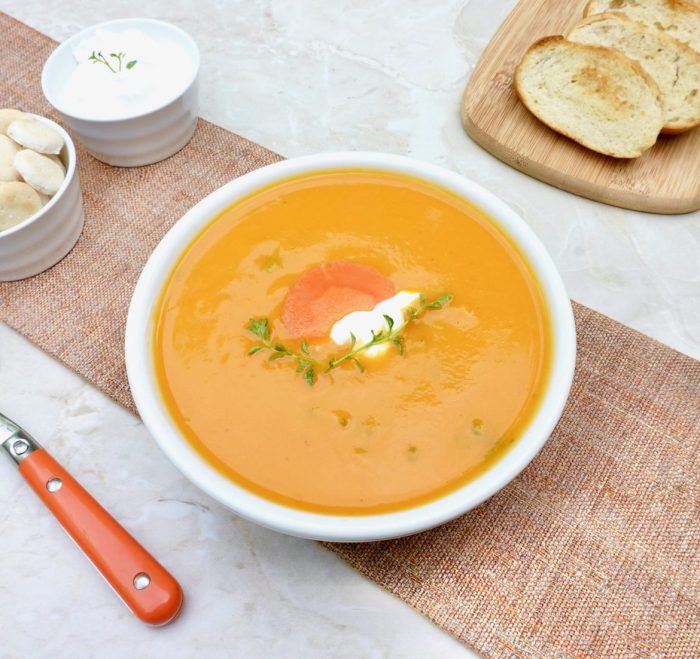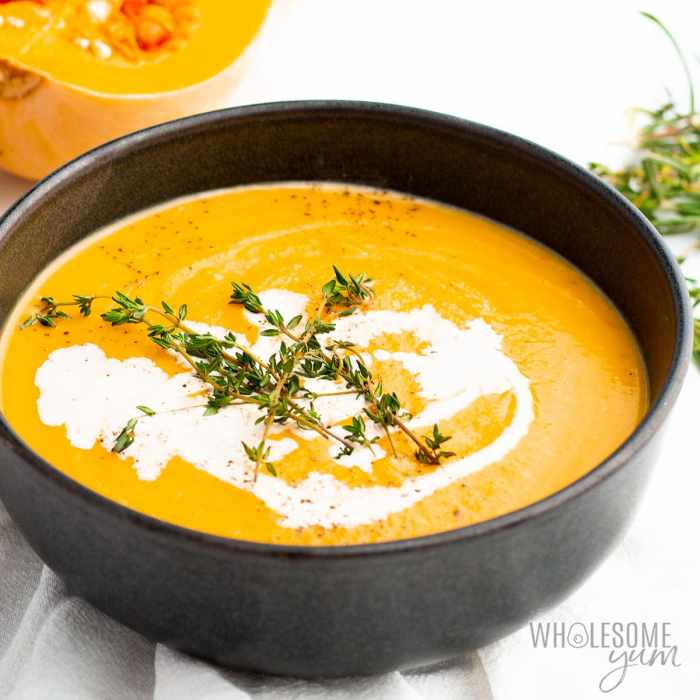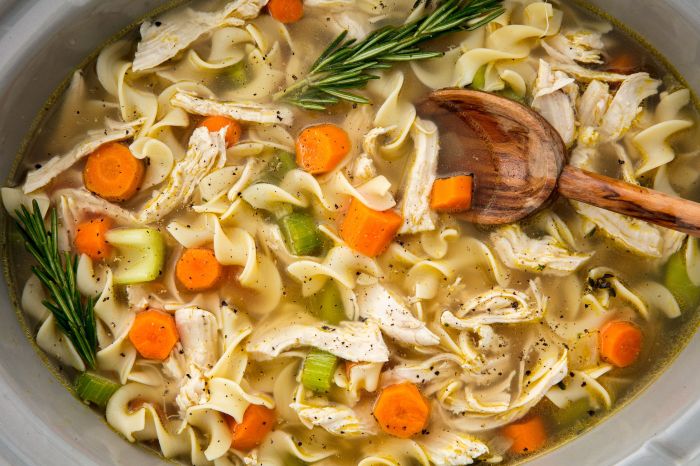Recipe Variations
Butternut squash soup recipe with carrots – Butternut squash and carrot soup is incredibly versatile, allowing for adjustments to suit various palates. The base recipe provides a delicious foundation, but adding different spices can transform the soup’s character, creating a range of flavor profiles from subtly sweet to intensely spicy. Below are three variations, each highlighting a different spice level.
Mild Butternut Squash and Carrot Soup
This variation emphasizes the natural sweetness of the butternut squash and carrots, with a hint of warmth from gentle spices. The creamy texture and vibrant orange hue make it visually appealing and perfect for a light lunch or starter.The soup’s color is a deep, rich orange, almost a golden hue, due to the natural colors of the butternut squash and carrots.
The texture is luxuriously smooth and creamy, achieved through careful blending.
Medium-Spiced Butternut Squash and Carrot Soup
This recipe introduces a moderate level of spice, adding depth and complexity to the familiar flavors. The addition of warming spices balances the sweetness of the vegetables, creating a more robust and flavorful soup.The color remains a vibrant orange, but with slightly deeper tones than the mild version. The texture is still creamy, but the addition of spices might give it a slightly thicker consistency.
Spicy Butternut Squash and Carrot Soup
This variation is for those who appreciate a kick! The generous addition of chili flakes and other warming spices creates a hearty and flavorful soup with a delightful heat. The vibrant color and creamy texture remain, but the overall experience is significantly bolder.The color is a deep, intense orange, possibly with flecks of red from the chili flakes. The texture remains smooth and creamy, but the spices add a slightly more robust mouthfeel.
Comparison of Butternut Squash and Carrot Soup Variations, Butternut squash soup recipe with carrots
The following table summarizes the key differences between the three variations:
| Recipe Variation | Spice Level | Key Ingredient Additions | Visual Appeal |
|---|---|---|---|
| Mild | Mild | Nutmeg, cinnamon | Deep golden-orange, smooth and creamy texture. |
| Medium-Spiced | Medium | Ginger, cumin, a pinch of cayenne pepper | Vibrant orange with slightly deeper tones, creamy texture. |
| Spicy | Spicy | Chili flakes, chipotle powder, smoked paprika | Deep, intense orange with red flecks, smooth and creamy texture with a slightly more robust mouthfeel. |
Ingredient Sourcing and Preparation: Butternut Squash Soup Recipe With Carrots

Source: anothertablespoon.com
Creating a truly delicious butternut squash and carrot soup hinges on selecting the right ingredients and preparing them correctly. The quality of your produce directly impacts the final flavor and texture of the soup, so careful consideration at this stage is key.This section details the best types of butternut squash and carrots to use, provides a step-by-step guide to their preparation, and discusses the advantages of using fresh versus frozen ingredients.
Choosing the Best Butternut Squash and Carrots
Selecting high-quality butternut squash and carrots is crucial for optimal flavor and texture. Look for butternut squash that is firm, heavy for its size, and free from bruises or soft spots. The skin should be smooth and a deep, consistent color. A slightly elongated shape is generally preferred, as it often indicates a higher flesh-to-seed ratio. For carrots, choose those that are firm, smooth, and brightly colored—a deep orange indicates high beta-carotene content.
Avoid carrots with blemishes, cracks, or signs of wilting. The best carrots for soup are usually medium-sized, as they offer a good balance of tenderness and flavor.
Preparing the Butternut Squash
Proper preparation of the butternut squash is essential for achieving a smooth, creamy soup.
- Washing and Cutting: Begin by thoroughly washing the butternut squash under cold running water. Use a vegetable brush to remove any dirt. Cut the squash in half lengthwise. Imagine a vertical slice down the middle; this gives you two symmetrical halves.
- Seed Removal: Using a spoon, scoop out the seeds and stringy pulp from the center of each squash half. A large spoon works well for this task; it makes quick work of removing all the inner material.
- Peeling: Peel the skin from each squash half using a vegetable peeler. The skin is quite tough, so a sharp peeler is essential for efficient peeling. A dull peeler will require more force and can be more challenging. The peeled squash will reveal a vibrant orange flesh.
- Cubing: Cut the peeled squash halves into roughly 1-inch cubes. Uniform size ensures even cooking. This will also assist in creating a smooth puree later.
Preparing the Carrots
Carrots require less preparation than butternut squash.
- Washing: Thoroughly wash the carrots under cold running water. Scrub them gently with a vegetable brush to remove any dirt or debris.
- Peeling (Optional): For this recipe, peeling is optional. If you prefer a smoother soup, peel the carrots. If you prefer a slightly more rustic texture, leave the skins on—they add a subtle earthiness to the soup.
- Chopping: Chop the carrots into roughly ½-inch pieces. This smaller size allows them to cook more quickly and blend smoothly into the soup.
Fresh vs. Frozen Ingredients
Using fresh butternut squash and carrots offers the best flavor and texture. The vibrant sweetness and smooth consistency of fresh produce cannot be fully replicated with frozen ingredients. However, frozen ingredients are a convenient alternative. If using frozen, ensure the vegetables are completely thawed before adding them to the soup to prevent uneven cooking and a watery texture.
The flavor will be slightly less intense than with fresh ingredients, but the overall result can still be quite enjoyable, especially if you adjust the seasoning to compensate for any perceived loss of flavor intensity.
A creamy butternut squash soup with carrots is a fantastically flavorful and healthy option, perfect for a weeknight meal. If you’re looking for quick and easy recipes, consider checking out this resource for busy soup recipe ideas to get inspiration for your own time-saving adaptations. The sweetness of the carrots complements the earthiness of the squash beautifully in this simple, yet satisfying soup.
Cooking Methods and Techniques
This section explores various cooking methods for butternut squash and carrot soup, highlighting the advantages and disadvantages of each approach. We will detail two primary methods—stovetop and slow cooker—before moving on to techniques for achieving a velvety smooth texture and the flavor enhancement achieved through roasting.
Stovetop versus Slow Cooker Methods
Choosing between stovetop and slow cooker methods depends largely on your available time and desired level of involvement in the cooking process. Both methods yield delicious results, but offer distinct advantages.
- Stovetop Method: This method offers quicker cooking times, allowing for a more immediate meal. It provides greater control over the cooking process, allowing for adjustments to consistency and seasoning as needed. However, it requires more hands-on attention throughout the cooking period.
- Slow Cooker Method: The slow cooker method is ideal for busy schedules, requiring minimal hands-on time. The long, low cooking time results in incredibly tender vegetables and a deeply flavorful soup. However, it requires more planning ahead and less control over the cooking process once started.
Achieving a Smooth and Creamy Soup with an Immersion Blender
Using an immersion blender is the most efficient and convenient way to create a smooth and creamy butternut squash and carrot soup directly in the pot. This eliminates the need for transferring the hot soup to a blender, reducing the risk of burns and spills.
- Once the vegetables are cooked, carefully submerge the immersion blender into the soup, ensuring it’s fully immersed to avoid splashing.
- Slowly blend the soup in a circular motion, moving the blender up and down to ensure even blending. This process typically takes a few minutes, depending on the desired consistency.
- Potential Issue: If the soup is too thick, add a little broth or water, a tablespoon at a time, while blending to reach the desired consistency. If it’s too thin, continue blending for a longer period, allowing the heat to slightly thicken the soup.
- Potential Issue: Large vegetable chunks may remain unblended. In this case, it’s best to use a sieve or fine-mesh strainer to remove any large pieces before blending again. Alternatively, you could use a standard blender for a finer puree, taking necessary precautions to avoid burns from the hot soup.
Roasting Vegetables for Enhanced Flavor
Roasting the butternut squash and carrots before making the soup significantly enhances their natural sweetness and creates a more complex flavor profile. The Maillard reaction, which occurs during roasting, contributes to the rich, nutty notes in the final soup.
- Preheat your oven to 400°F (200°C).
- Peel, deseed, and cube the butternut squash and carrots into roughly 1-inch pieces. Toss them with olive oil, salt, pepper, and any other desired herbs (e.g., thyme, rosemary).
- Spread the vegetables in a single layer on a baking sheet to ensure even roasting.
- Roast for approximately 30-40 minutes, or until the vegetables are tender and slightly caramelized. The edges should have a nice golden brown color.
- Once roasted, allow the vegetables to cool slightly before adding them to your chosen cooking method (stovetop or slow cooker).
Flavor Enhancements and Garnishes

Source: wholesomeyum.com
Elevating the simple yet comforting flavors of butternut squash and carrot soup requires careful consideration of both complementary spices and visually appealing garnishes. The right additions can transform a good soup into a truly memorable culinary experience. This section explores effective flavor enhancements and presentation techniques to achieve this.
Three herbs or spices that beautifully complement the inherent sweetness of butternut squash and carrots are sage, ginger, and nutmeg. Sage, with its earthy and slightly peppery notes, provides a sophisticated depth that balances the sweetness. Ginger adds a warm, spicy kick that brightens the overall flavor profile, preventing the soup from becoming overly cloying. Nutmeg, with its subtle warmth and aromatic complexity, introduces a touch of elegance and complements the squash’s natural sweetness.
Garnish Options for Enhanced Presentation and Taste
Appropriate garnishes not only enhance the visual appeal of the soup but also contribute additional layers of flavor and texture. The following options offer a variety of sensory experiences.
- Toasted Pepitas (Pumpkin Seeds): These offer a satisfying crunch and a nutty flavor that complements the sweetness of the soup. Visually, the green and tan seeds provide a vibrant contrast against the soup’s orange hue.
- Crispy Sage Leaves: Deep-fried or baked until crisp, sage leaves add a beautiful green accent and a concentrated burst of sage flavor. The contrast in texture between the crispy leaves and the smooth soup is delightful.
- Chives: Finely chopped chives offer a delicate, oniony flavor and a bright green color that adds visual appeal. Their subtle flavor doesn’t overpower the soup’s other components.
- A swirl of Crème Fraîche or Coconut Cream: A dollop of crème fraîche or coconut cream adds a luxurious richness and a visually striking contrast in texture and color. The creamy white swirl stands out beautifully against the orange soup.
- Roasted Carrot Ribbons: Thinly sliced and roasted carrots offer a concentrated sweetness and a pleasing textural contrast. Their vibrant orange color enhances the overall visual appeal, creating a visually cohesive presentation.
Impact of Different Broth Types on Flavor Profile
The choice of broth significantly impacts the final flavor of the soup. Different broths contribute unique nuances that can either enhance or detract from the inherent flavors of the butternut squash and carrots.
Vegetable broth provides a clean, pure base that allows the natural sweetness of the squash and carrots to shine. Chicken broth, on the other hand, introduces a savory richness and depth that can create a more complex flavor profile. The richness of chicken broth can complement the sweetness of the vegetables, creating a balanced and satisfying taste. Using a homemade broth, whether vegetable or chicken, will result in a more intense and nuanced flavor compared to commercially produced broths.
A lighter broth, such as a simple vegetable broth, is better suited if you want the vegetables’ flavors to be the focus. Conversely, a richer broth, like chicken or even a beef broth, might be preferable if you are aiming for a heartier, more savory soup.
Serving Suggestions and Pairings
This section explores various ways to serve your delicious butternut squash and carrot soup, considering different meal occasions and complementary accompaniments to enhance the overall dining experience. We will also discuss adaptations for dietary restrictions, ensuring everyone can enjoy this hearty and flavorful soup.
Serving Suggestions for Butternut Squash and Carrot Soup
The versatility of butternut squash and carrot soup allows it to be enjoyed in a variety of settings. Its creamy texture and subtly sweet flavor profile make it adaptable to different meal structures and occasions. The following table Artikels four distinct serving suggestions, highlighting the appropriate context for each presentation.
| Serving Style | Meal Occasion | Portion Size | Presentation |
|---|---|---|---|
| Appetizer/Starter | Dinner party, special occasion | Small bowl (6-8 oz) | Garnished with a swirl of cream and toasted pumpkin seeds. |
| Main Course | Light lunch, casual dinner | Larger bowl (10-12 oz) | Served with a crusty bread bowl or alongside a grilled cheese sandwich. |
| Side Dish | Family dinner, buffet | Smaller bowl (4-6 oz) | Presented in a chafing dish or self-serve buffet style. |
| Soup Course | Formal multi-course meal | Medium bowl (8-10 oz) | Served in elegant bowls, possibly with a delicate garnish. |
Bread and Accompaniment Suggestions
Choosing the right accompaniment can significantly elevate the enjoyment of butternut squash and carrot soup. The following suggestions highlight pairings that complement the soup’s flavors and textures.
Firstly, crusty bread, particularly a sourdough or a rustic country loaf, offers a delightful textural contrast to the creamy soup. The slightly tangy notes of sourdough also complement the sweetness of the squash and carrots.
Secondly, a cornbread muffin provides a sweeter, more subtly textured counterpoint. The sweetness of the cornbread harmonizes well with the natural sweetness of the soup, offering a balanced flavor profile.
Thirdly, toasted pumpkin seeds offer a crunchy texture and a nutty flavor that adds a depth of complexity to the soup. Their earthy tones complement the overall flavor profile without overpowering it.
Dietary Adaptation: Gluten-Free and Vegan Versions
Adapting the butternut squash and carrot soup recipe to suit different dietary needs is straightforward.
For a gluten-free version, simply ensure that any added bread or croutons are certified gluten-free. Many commercially available gluten-free bread options are readily available, and you can even make your own using gluten-free flour blends.
To create a vegan version, replace any dairy-based cream or butter with plant-based alternatives. Coconut cream, cashew cream, or even full-fat coconut milk can provide a rich and creamy texture without compromising the flavor. Ensure that any stock used is also vegetable-based.
Quick FAQs
Can I use canned butternut squash?
Yes, canned butternut squash works well, but fresh offers a superior flavor and texture. If using canned, drain well before adding to the recipe.
How long can I store leftover soup?
Store leftover soup in an airtight container in the refrigerator for up to 3-4 days.
Can I freeze this soup?
Yes, this soup freezes well. Allow it to cool completely before freezing in airtight containers for up to 2-3 months.
What if my soup is too thick?
Add a little broth or water to thin the soup to your desired consistency.
What if my soup is too thin?
Simmer the soup uncovered for a while to reduce the liquid and thicken it. You can also add a cornstarch slurry (1 tbsp cornstarch mixed with 2 tbsp cold water) to thicken.


